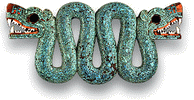Findings confirm struggle between maya cities
Category: News reportsINAH, may 28, 2009. An unarticulated human body sculpture and 6 Maya stone carved masks covered with green and blue stucco were found in an offering during the Moral-Reforma archaeological site exploration, In the Tabasco municipality of Balancan. Items could be more than 1,500 years old and would confirm that the Maya settlement was in dispute between Calakmul and Palenque seigniories.
Archaeologist Francisco Cuevas Reyes is in charge of the National Institute of Anthropology and History (INAH) excavation, which began in March 23rd 2009. He informed that the offering was found in the Building 14, the most emblematic due to its 27 meters height. The Palenque-styled masks have different sizes and each has its own design. They were placed around the human sculpture which head and members were separated from the thorax. The discovery might be dated between 300 and 600 AD, at the peak of the city, although the material still has to undergo analysis.
Cuevas declared that the offering might have been dedicated to the pyramid, defining a change of domain of Moral-Reforma to an external settlement. The sculptural style of the pieces must be determined to correctly define its significance and antiquity, confirming the epigraphic information found in the site, referring to a dispute between Calakmul and Palenque to take control of this city.
The sculpture, which head has not been found, was mutilated before being placed as an offering, probably as a symbol of the new government imposition. Arms and legs were fractured and placed next to the figure. The masks present at the back the figure of a leaf and the imprint of its vein. Under the stucco finishing, the carving of the face can be noticed. INAH restorers will intervene the masks to fix pigments, stop deterioration and consolidate stucco cover that would detach. INAH experts have determined that the sculpture weights 150 kilosand is more than 1 meter high and 46 centimeters wide. “Masks can be divided in 2 groups: 3 little ones, 15 centimeters wide and 11 high, while 3 reach 25 centimeters long by 19 wide”, declared archaeologist Cuevas.
Ceramic pieces have been found, as well as projectile heads, which are being analyzed at the Tabasco INAH Center laboratory. Most of them belong to Early Classic period.
The Maya site was occupied between 250 and 750 AD, and according to epigraphic studies it has been determined that near 660, El Moral-Reforma was subdued to Calakmul, while near 690, Palenque dominated it. El Moral-Reforma is located by San Pedro River, which represented in Prehispanic times an important commercial route since it connected with Guatemalan Peten, Usumacinta River and the Gulf Coast. Flintstone, abundant in the zone, was exploited and this contributed to the interest that Calakmul and Palenque had on the region.
Source: INAH.


